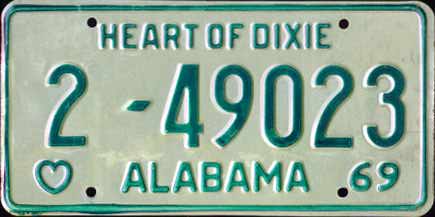
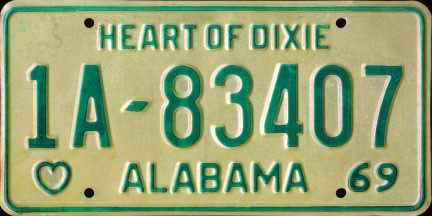
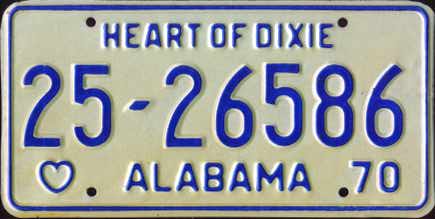
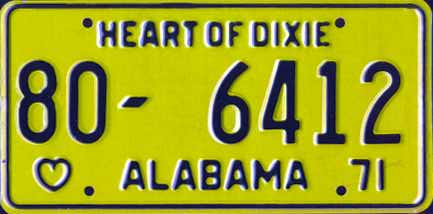

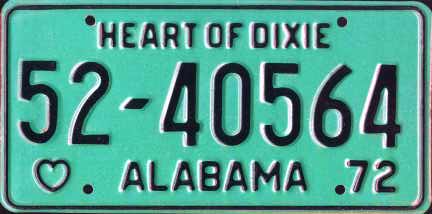
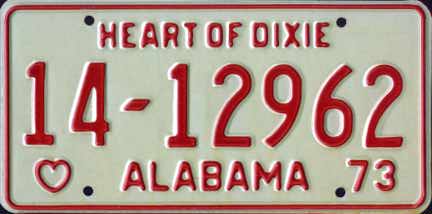
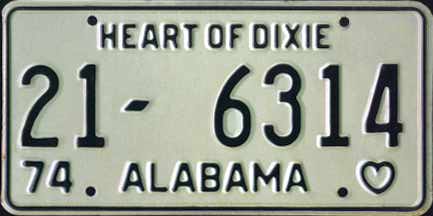
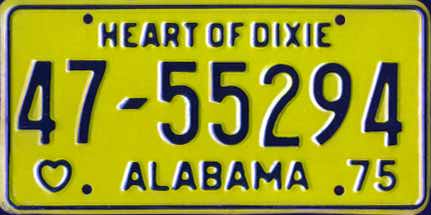
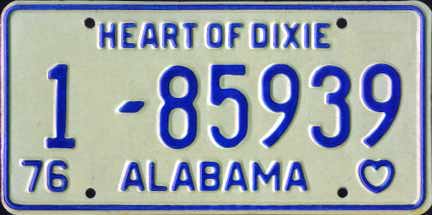

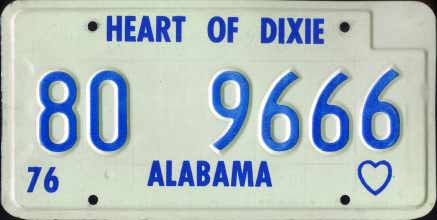

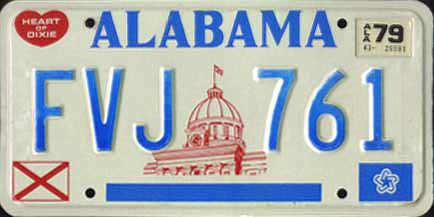
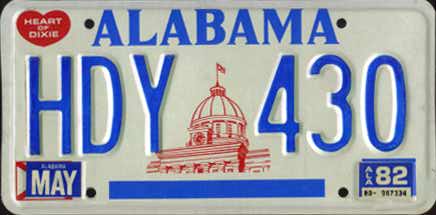
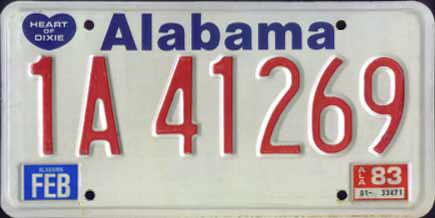
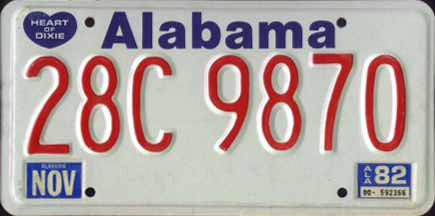


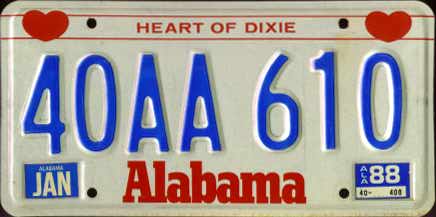
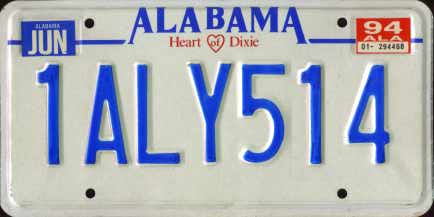
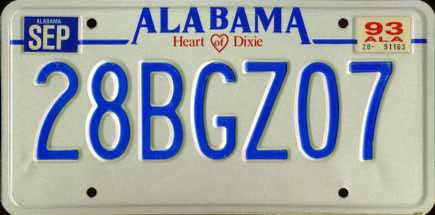
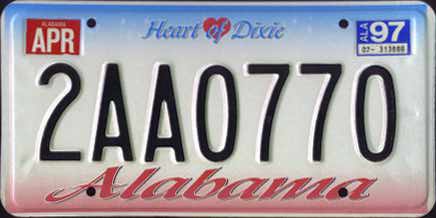
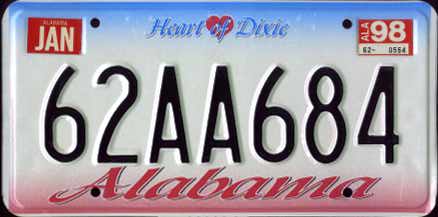
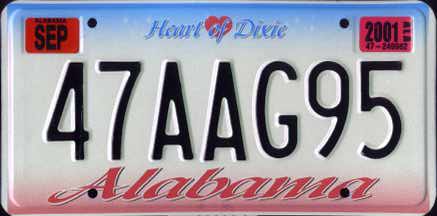

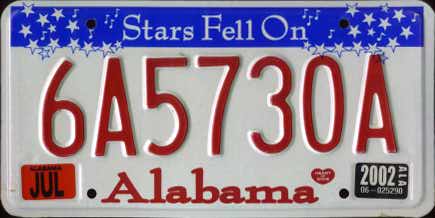
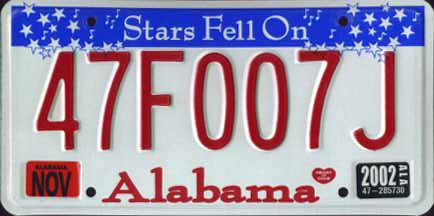
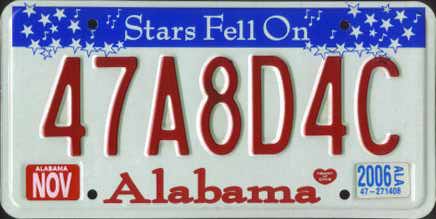
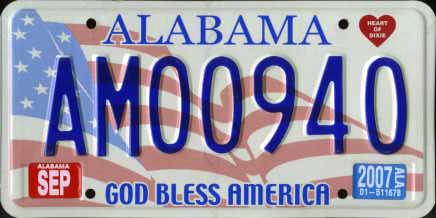
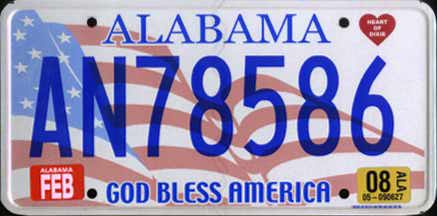

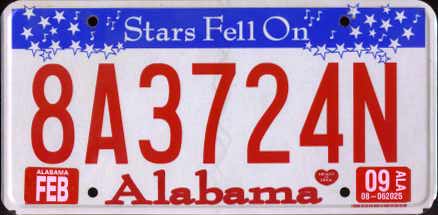
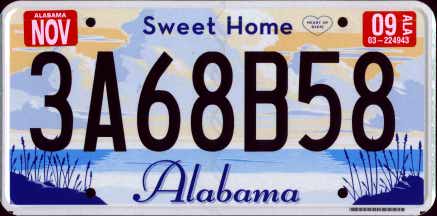
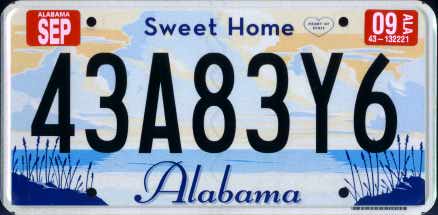
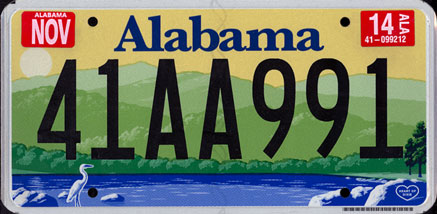
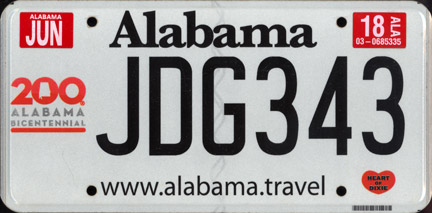
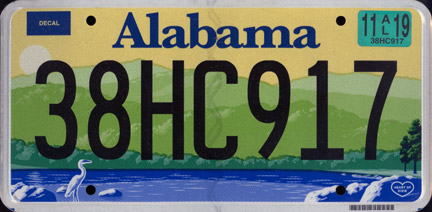

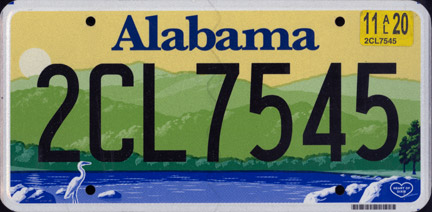
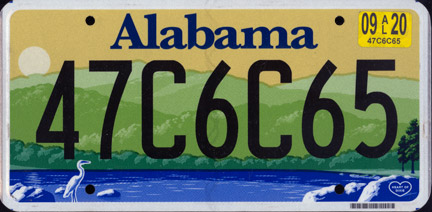
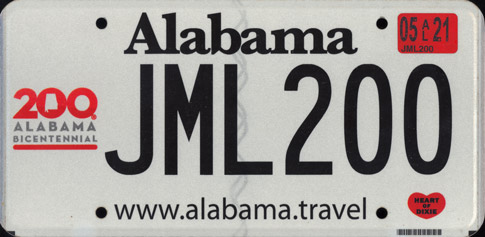
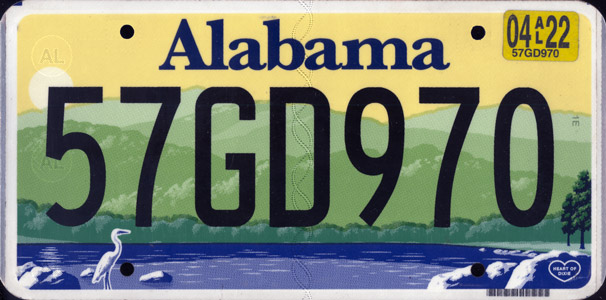
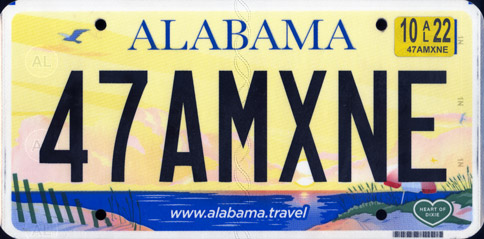
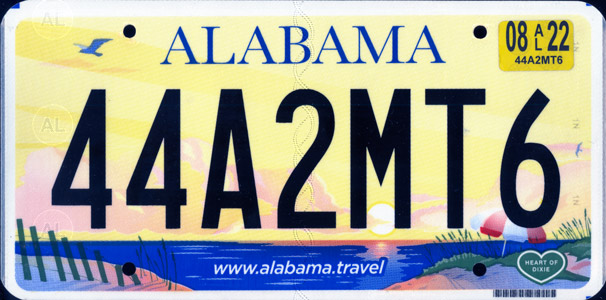

 |
Alabama 1969 passenger issue. The "Heart of Dixie" slogan and a heart in some form or another have appeared on Alabama plates continuously from 1955 to the present. Plates of this era carried a county code prefix. County codes 1-3 were issued to the state's most populous counties, and the rest were issued alphabetically. Click here for a full listing of Alabama county codes. This plate came from county #2, Mobile county. |
 |
Alabama 1969 passenger issue. This plate came from county #1, Jefferson county. In the more populous counties, plate numbers often exceeded 99,999, and in cases such as this a letter was added to extend the series. This "1A" plate is such a case. |
 |
Alabama 1970 passenger issue. These plates were similar in design to the previous issue, with the colors changed from green on white to blue on white. This plate was issued in county #25, Cullman county. |
 |
Alabama 1971 passenger issue. Although the county code numbers for the state only go up to 67, some plates of this era can be seen with codes of "70" or "80". Code 70 plates were used as replacements for lost or stolen plates, and Code 80 plates were listed as "supplemental", presumably used for cases where a county either ran out of its allocated plates or plates with the correct county code were otherwise unavailable at the time. |
 |
Alabama 1971 passenger issue. Another overflow issue from Jefferson county, with the alpha character advancing once again to the 'B' series after the initial all-numeric and subsequent 1A series were exhausted. |
 |
Alabama 1972 passenger issue. This plate has one of the more interesting color combinations of this era in U.S. plate history. The colors were used in honor of the Tuskegee Institute (now Tuskegee University), founded in 1881 in Tuskegee, Alabama. These black-on-mint plates were rather difficult to read at a distance, however. This specimen was issued in county #52, Morgan county. |
 |
Alabama 1973 passenger issue. Alabama returned to a more traditional color scheme for 1973. This plate was issued in Chilton county, #14. |
 |
Alabama 1974 passenger issue. This plate reversed the embossed heart and year to opposite bottom corners of the plate from previous issues. This particular plate was issued in Conecuh county, #21. |
 |
Alabama 1975 passenger issue. The heart and date are once again in their traditional locations, resulting in a plate design almost identical to the 1971 release. This plate was issued in county #47, Madison county. |
 |
Alabama 1976 passenger issue. Heart and year reversed again on this issue. 1976 marked the final year for yearly plate issues in Alabama. This plate was once again issued in county #1, Jefferson county. |
 |
Alabama 1976 passenger issue. Another standard 1976 issue, this one is missing the dash between the county code and serial, which was a common occurrance on these plates. This one was also issued in Madison county, code #47. |
 |
Alabama 1976 passenger issue. This was a late-issue 1976 Alabama plate, produced after production of the 1977 graphic issue had already started. Late-production plates such as this were made by painting the background onto a plain 1977 plate blank and embossing just the numbers onto the plate. This was another code 80 plate, a supplemental issue for counties that ran out of standard plates. |
 |
Alabama 1978 passenger issue. At the end of 1976, this ambitious graphic plate was introduced in Alabama. Pictured is the state capitol building, the state flag, the U.S. Bicentennial flag, and a "Heart of Dixie". This plate was the only issue from 1942 to present not to carry a county code as part of the serial. The standard baseplate has a narrow blue rectangle at the bottom of the plate, which on early registrations was covered by a county sticker. It was left uncovered in other cases. This plate carries a sticker from Pike county. This baseplate was used with stickers through the end of 1982. |
 |
Alabama 1979 passenger issue. Most new registrants after 1977 were issued this baseplate without a county sticker at the bottom, so the blue rectangle shows at the bottom where the sticker was intended to go. This particular plate is also part of a second variation of this base, with the sticker well at the top right changed and the screened "'77" removed. Staggered registration was introduced in Alabama starting in 1981, so motorists were instructed to place the month and year stickers in the bottom corners of the plate, covering part of the graphics. This plate was used through the end of 1982. |
 |
Alabama 1982 passenger issue. The third variation of the Capitol base featured larger dies, which have been used on all Alabama issues since. These plates also have sticker wells at the bottom corners to accommodate month and year stickers. These changes were both most likely due to the simultaneous production of these late-period plates on this base while supplies of the state's next baseplate (using both the larger dies and sticker well placement) were being stocked. This variation is rather rare and usually only seen with natural 1982 stickers. |
 |
Alabama 1982/1983 passenger issues. This relatively simple baseplate was introduced in 1982 and was issued through the end of 1987. These plates were valid with stickers through the end of 1989. County codes were re-introduced on this issue. The standard format for two-digit counties at this time was 12A 1234. Counties 1-9 used a 1A 12345 format. |
 |
|
 |
Alabama 1987 passenger issue. The growing population in Madison county (greater Huntsville) caused an issue on this baseplate when the county ran out of available standard-format combinations. As a result, after plate number 47Z 9999, a new overflow all-numeric format was used for the county. This represented the first time that Madison county was issued its own specific overflow format, an occurrance that would happen again on the 1997 and 2002 bases, and is also likely on the 2009 base. |
 |
Alabama 1988 passenger issues. This plate was introduced at the end of 1987 and issued through the end of 1992. It remained valid with stickers through the end of 1993. Two-digit counties on this plate were issued in a 12AB 123 format. County codes below 10 were issued in a 1AB 1234 format. |
 |
|
  |
Alabama 1993/1994 passenger issues. This base was first issued in 1993 and was used through the end of 1997. The format was 12ABC34, with counties below 10 (like this plate) using a 1ABC234 format. |
  |
Alabama 1997/1998 passenger issues. This base was introduced in January, 1997 and was issued through the end of 2001. This plate, featuring stylized printing for the state name and slogan, plus twinkling stars in the "sky", was definitely one of the more distinctive issues in recent memory. The format in use was 12AB123, with counties 1-9 using 1AB1234. |
 |
Alabama 2001 passenger issue. Late-period overflow plate from Madison county. Madison county has the largest population of any of the two-digit county codes, and ran out of combinations in the standard two-alpha format after plate number 47ZZ999 was reached. Additional three-alpha plates in the 47ABC23 format were produced to accomodate overflow registrations. |
 |
Alabama 2002 passenger issue. Even later-period overflow plate from Madison county. For some reason, the 47ABC23 format was discontinued in 2001 and replaced with this 47A2B34 format to handle the county's registrations through the remainder of 2001. |
  |
Alabama 2002 passenger issues. This plate was introduced in January, 2002. The new slogan on these plates is "Stars Fell on Alabama," in reference to the 1934 song written by Mitchell Parish and Frank Perkins and made famous by Ella Fitzgerald and Louis Armstrong, Frank Sinatra, and other artists over the years. The top of the plate contains a field of stars and musical notes around the slogan. The introduction of this plate provided one of the stranger quotes I've seen from an elected official, from Gov. Don Siegelman: "It is my hope that this design will help send a message that stars have indeed fallen on Alabama and continue to fall on Alabama." Sounds more like a pitch for federal disaster relief than a tourist slogan. The "Heart of Dixie" remained as well, although in a form too small to be read at any distance. These plates met with decidedly mixed reviews since their release. Plates are issued in a serial format of 1A2345B for one-digit counties, or 12A345B for two-digit counties. |
 |
Alabama 2006 passenger issue. Continuation of the series above. Once again, Madison county overran its allocation of standard-format numbers upon reaching 47Z999Z in 2005. At this point, this new overflow 47A1B2C format was introduced. |
 |
Alabama 2007/2008 passenger issues. In 2006, Alabama joined the ranks of states issuing no-cost God-themed optional plates with this "God Bless America" issue. Early issues of the plate were embossed, with later issues being produced as flat plates such as this one. This has proven a popular optional plate in the state, to the point where it has become the de facto general issue in some counties. Plates are issued in two formats, with two-alpha prefixes such as this, or two-alpha suffixes. There is no county coding on these plates, aside from a small prefix on the validation sticker. |
 |
|
 |
Alabama 2008/2009 passenger issue. Beginning in 2008, Alabama's "Stars Fell On" general issue "went flat," becoming produced using 3M's digital flat plate technology rather than the older embossed style. Introduction of the flat plates varied by county, as supplies of the older embossed plates were depleted. As a result, not every county would have issued flat plates on this base, which was discontinued starting in January, 2009. |
 |
|
 |
Alabama 2009 passenger issue. This general issue was released for Alabama starting in January, 2009. This issue featured a graphic of a tranquil water scene with passing clouds in the background and the slogan "Sweet Home Alabama." From Sinatra to Skynyrd, I suppose. Turn it up. Serial format on this base is 1A23B45 for counties 1-9, and 12A34B5 for counties 10 and above. These plates come from county #3, Montgomery and #43, Lee. |
 |
|
 |
Alabama 2014 passenger issue. This new issue was introduced in January, 2014 and again featured a landscape, this time with rolling hills behind a lake scene. The required Heart of Dixie slogan is included in very small form at bottom right. These plates are issued in a more straightforward 1AB2345 or 12AB234 format, previously used on both the 1987 and 1997 bases. This plate was issued in Lauderdale county, #41. |
 |
Alabama 2018 passenger issue (no-fee alternate). Alabama introduced a third no-fee passenger option in 2016 to commemorate the state's 2019 bicentennial. These plates featured the state bicentennial logo to the left of a six-digit serial, which started at JAA-001. It also featured the state's tourism website address and requisite Heart of Dixie at the bottom. These plates were discontinued at the end of 2020 and slated for replacement throughout 2021. |
 |
Alabama 2019 passenger issue. Continuation of the 2014 base, starting in 2018 the state moved to single print-on-demand validation stickers containing both the month and year of expiration, along with the plate number. As a result, some plates issued in 2018 or later have the single sticker showing along with a blue DECAL box at the top where the old-style month sticker would have gone. This is such an issue from Houston county, #38. |
 |
Alabama 2020 passenger issue. In 2018, Madison county ever-predictably overran their allocation of plates in the standard 47AB123 format and switched to their overflow format of 47A1B23. This is an example of an early-ish overflow issue with a single validation sticker and the DECAL box showing as noted above. Shelby county, #58, also overran its allocation for the first time in 2018, joining Madison in using this overflow format. |
 |
Alabama 2020 passenger issue. Alabama removed the no-longer-needed top left DECAL box as stock of the old bases ran out in 2019, leading to plates like this with the full yellow sky treatment at top left. This issue is from Mobile county (#2) and it strikes me that this is the first example of a single-digit county format (1AB2345) I've posted on this base. So there you go. |
 |
Alabama 2020 passenger issue. Madison county overflow issue of the DECAL box-less base shown above. Nothing else to see here. |
 |
Alabama 2021 passenger issue (no-fee alternate). The Alabama Bicentennial base went through a similar set of changes to the standard base with regards to the month sticker and eventually the space for said sticker being discontinued starting in 2018. This is a late issue bicentennial with single 2021 expiration and no DECAL box at top left. |
 |
Alabama 2022 passenger issue. At the tail end of the 2014 base Alabama switched to 3M's HD sheeting, resulting in one last variation before the the plates were replaced in 2021-22. This example was issued in Russell county (#57). |
 |
Alabama 2022 passenger issue. Alabama released a new baseplate in late 2021, featuring a beach motif. This issue retains the county coding from prior issues but uses an Arizona-style alphabet soup arrangement for the serial, so there's no set serial format for single or double-digit counties, and Madison county won't be an overflow outlier this time. This Madison plate is from a particularly egregious all-letters soup arrangement. Casual observation suggests the letter immediately after the county code will be the last character to flip, so these plates tend to be issued starting with the county code and A, then a relative mis-mash of letters and numbers. |
 |
Alabama 2022 passenger issue. Another example of the 2021 issue, showing a different alphabet soup serial arrangement. This one was issued in Limestone county, #44. |
Additional Alabama information provided by: Lowell McManus
| Ahead to Alaska | |
| Back to Main Page |
Return to U.S. Plates Index
Last Modified 7/8/2023 (added 2022 plates).